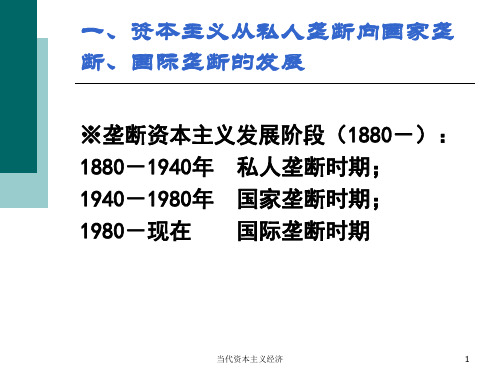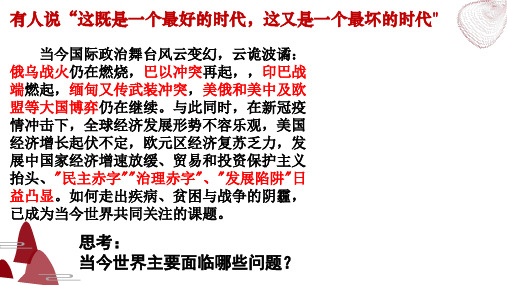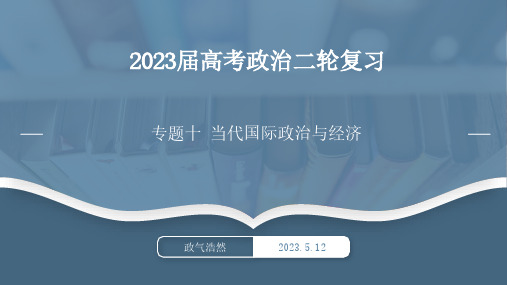《当代美国经济》PPT课件
合集下载
当代美国课件

26
《当代美国》教学大纲 任军利
2012-12-18
二是1776年《独立宣言》。杰斐逊用饱含
激情的笔调写下“人人生而平等”这句对 后世产生重大影响的法律文件。这个思想 对美国政治制度确立奠定了基础。
三是1781年《邦联条款》。这个条款规定
美国13个州是一个联盟体,但各州又可以 保留自已的主权、自由和独立。
25
《当代美国》教学大纲 任军利
2012-12-18
美国宪法在形成过程中充满着对理想社 会的追求,宪法的发展就是为了实现这种 理想。具体地说对美国宪法起了关键性作 用的有这样这几个历史事件。
一是1620年一批清教徒远涉重洋来到北美
新大陆,在船上签订的《五月花号公约》。 它约定在新大陆要使“保护宗教自由和公 正平等的法律成为可能”。
30
《当代美国》教学大纲 任军利
2012-12-18
美国联邦宪法有这样几个特点: 一:首创成文宪法。将公民权利、国家结
构和组织形式明确记载于一部名为“宪法” 中。 二:首创总统共和制。当时美国建国时世 界上有两种政体:君主立宪制 小国共和 制。将共和制与大国连在一起是美国。这 即否定了君主制,又建立了强有力的政府, 这无疑是一种制度创新。
18
《当代美国》教学大纲 任军利
2012-12-18
第二,移民数量大,每年移居美国的移民都达几
十万人。上世纪头10年有900万人到美国,第二 个10年有700万人,30年代有52.8万人,50年代 有200万人,60年代250万人,70年代450万人。 第三,移民种类多。求学、探亲和避难。 第四,移民在教育和专业技能上一般具有较高的 素质。 第五,有大量的非法移民。 第六,新移民的居住地域相对集中。夏威夷、加 利福尼亚、佛罗里达、新泽西、纽约。洛杉机、 芝加哥、旧金山、迈阿密。 2、美国社会各民族群体之间的结构性不平等。 主要表现在:产业、城市化程度、教育、就 业、职业、收入。
《当代美国》教学大纲 任军利
2012-12-18
二是1776年《独立宣言》。杰斐逊用饱含
激情的笔调写下“人人生而平等”这句对 后世产生重大影响的法律文件。这个思想 对美国政治制度确立奠定了基础。
三是1781年《邦联条款》。这个条款规定
美国13个州是一个联盟体,但各州又可以 保留自已的主权、自由和独立。
25
《当代美国》教学大纲 任军利
2012-12-18
美国宪法在形成过程中充满着对理想社 会的追求,宪法的发展就是为了实现这种 理想。具体地说对美国宪法起了关键性作 用的有这样这几个历史事件。
一是1620年一批清教徒远涉重洋来到北美
新大陆,在船上签订的《五月花号公约》。 它约定在新大陆要使“保护宗教自由和公 正平等的法律成为可能”。
30
《当代美国》教学大纲 任军利
2012-12-18
美国联邦宪法有这样几个特点: 一:首创成文宪法。将公民权利、国家结
构和组织形式明确记载于一部名为“宪法” 中。 二:首创总统共和制。当时美国建国时世 界上有两种政体:君主立宪制 小国共和 制。将共和制与大国连在一起是美国。这 即否定了君主制,又建立了强有力的政府, 这无疑是一种制度创新。
18
《当代美国》教学大纲 任军利
2012-12-18
第二,移民数量大,每年移居美国的移民都达几
十万人。上世纪头10年有900万人到美国,第二 个10年有700万人,30年代有52.8万人,50年代 有200万人,60年代250万人,70年代450万人。 第三,移民种类多。求学、探亲和避难。 第四,移民在教育和专业技能上一般具有较高的 素质。 第五,有大量的非法移民。 第六,新移民的居住地域相对集中。夏威夷、加 利福尼亚、佛罗里达、新泽西、纽约。洛杉机、 芝加哥、旧金山、迈阿密。 2、美国社会各民族群体之间的结构性不平等。 主要表现在:产业、城市化程度、教育、就 业、职业、收入。
当代资本主义经济课件

(2)西方跨国公司的迅速扩张进一步 增强了西方大国的实力,使世界经济 力量对比进一步向美欧发达国家倾斜。
(3)跨国公司也强化了西方发达国家 对世界经济主导权的控制。
当代资本主义经济
11
负面影响:
1、资本主义由国家垄断转变为国际垄断。
2、改变了传统的生产要素受地域的限制, 从而冲击到资本主义国家的传统调节机制。
--“看不见的手”
1、财产私有制
2、利润驱动
3、价格体系、价格机制和价格决定
4、创业自由
5、竞争
6、个人奋斗
7、消费者至上
当代资本主义经济
13
(二)宏观经济调控
--“看得见的手” 1、美国政府的宏观经济调控 2、法国政府的宏观经济调控 3、日本政府的宏观经济调控
当代资本主义经济
14
1、美国政府的宏观经济调控 ——国家需求管理型市场经济体制
当代资本主义经济
24
2、知识经济对未来世界的影响
(1)对经济发展的影响
以制造业为中心
以服务业为核心;
知识拥有者迅速聚居财富,并以自己的新 价值观念影响着社会;
(2)对生活方式的影响
终生学习成为人们生存和发展的需要(学 习方式上);人们很乐意在家工作(工 作方式上)。
当代资本主义经济
25
3、西方国家迈向知识经济时代的举措
特点:
(1)政府从不制定中期、长期全国经济与 社会发展计划,单个资本生产的有计划经 营同全社会生产的无政府状态之间的矛盾 比较突出。
(2)为了达到“促进就业、生产和购买能 力”的目标,政府主要依靠制定和实施财 政政策和货币政策,对经济进行全面的短 期干预和调节。
☆这种调控方式的形成与以下因素有关。
(3)跨国公司也强化了西方发达国家 对世界经济主导权的控制。
当代资本主义经济
11
负面影响:
1、资本主义由国家垄断转变为国际垄断。
2、改变了传统的生产要素受地域的限制, 从而冲击到资本主义国家的传统调节机制。
--“看不见的手”
1、财产私有制
2、利润驱动
3、价格体系、价格机制和价格决定
4、创业自由
5、竞争
6、个人奋斗
7、消费者至上
当代资本主义经济
13
(二)宏观经济调控
--“看得见的手” 1、美国政府的宏观经济调控 2、法国政府的宏观经济调控 3、日本政府的宏观经济调控
当代资本主义经济
14
1、美国政府的宏观经济调控 ——国家需求管理型市场经济体制
当代资本主义经济
24
2、知识经济对未来世界的影响
(1)对经济发展的影响
以制造业为中心
以服务业为核心;
知识拥有者迅速聚居财富,并以自己的新 价值观念影响着社会;
(2)对生活方式的影响
终生学习成为人们生存和发展的需要(学 习方式上);人们很乐意在家工作(工 作方式上)。
当代资本主义经济
25
3、西方国家迈向知识经济时代的举措
特点:
(1)政府从不制定中期、长期全国经济与 社会发展计划,单个资本生产的有计划经 营同全社会生产的无政府状态之间的矛盾 比较突出。
(2)为了达到“促进就业、生产和购买能 力”的目标,政府主要依靠制定和实施财 政政策和货币政策,对经济进行全面的短 期干预和调节。
☆这种调控方式的形成与以下因素有关。
当代世界经济与政治课件

02 跨国威胁
跨国威胁如毒品走私、非法移民、网络犯罪等也 对全球安全构成了严重威胁。国际社会需要加强 合作,共同应对这些跨国威胁。
03 核武器与裁军
核武器是全球安全的最大威胁之一。国际社会应 该推动核裁军进程,降低核战争风险,维护全球 和平稳定。
国际组织与国际法
国际组织的作用
国际组织是维护全球和平、促进国际合作的重要机构。国际组织通过推动国际法和国际规则的制定和实施,促进各国 之间的合作与协调。
国际关系理论与政策制定
国际关系理论对于政策制定具有重要的指导意义。正确的理论指导可以帮助政策制定者 更好地把握国际形势,制定出更加科学合理的外交政策。
03
全球性问题与挑战
全球气候变化
总结词
全球气候变化是当代世界面临的最严峻挑战之一,它对生态环境、经济和社会发展都产生了深 远的影响。
详细描述
全球气候变化主要是由于人类活动导致的大量温室气体排放,引起地球温度升高、极端气候事 件频发、冰川融化、海平面上升等一系列问题。这些变化对自然生态系统、农业生产、水资源 、人类健康等方面造成了严重威胁,同时也加剧了国际政治经济格局的不稳定性。
会的共同努力和合作,推动经济、社会和环境的协调发展。
04
国际战略与政策
大国竞争与博弈
1 2 3
大国间的经济竞争
主要表现在贸易、投资、科技和人才等方面,这 些竞争对全球经济格局和各国发展具有重要影响 。
大国间的政治博弈
涉及地缘政治、国际话语权、国际制度和规则制 定等方面,这些博弈对国际秩序和地区稳定产生 深远影响。
粮食安全与可持续发展
总结词
粮食安全与可持续发展是当代世界经济发展中的重要议题,它们关系到人类的生存和发 展。
跨国威胁如毒品走私、非法移民、网络犯罪等也 对全球安全构成了严重威胁。国际社会需要加强 合作,共同应对这些跨国威胁。
03 核武器与裁军
核武器是全球安全的最大威胁之一。国际社会应 该推动核裁军进程,降低核战争风险,维护全球 和平稳定。
国际组织与国际法
国际组织的作用
国际组织是维护全球和平、促进国际合作的重要机构。国际组织通过推动国际法和国际规则的制定和实施,促进各国 之间的合作与协调。
国际关系理论与政策制定
国际关系理论对于政策制定具有重要的指导意义。正确的理论指导可以帮助政策制定者 更好地把握国际形势,制定出更加科学合理的外交政策。
03
全球性问题与挑战
全球气候变化
总结词
全球气候变化是当代世界面临的最严峻挑战之一,它对生态环境、经济和社会发展都产生了深 远的影响。
详细描述
全球气候变化主要是由于人类活动导致的大量温室气体排放,引起地球温度升高、极端气候事 件频发、冰川融化、海平面上升等一系列问题。这些变化对自然生态系统、农业生产、水资源 、人类健康等方面造成了严重威胁,同时也加剧了国际政治经济格局的不稳定性。
会的共同努力和合作,推动经济、社会和环境的协调发展。
04
国际战略与政策
大国竞争与博弈
1 2 3
大国间的经济竞争
主要表现在贸易、投资、科技和人才等方面,这 些竞争对全球经济格局和各国发展具有重要影响 。
大国间的政治博弈
涉及地缘政治、国际话语权、国际制度和规则制 定等方面,这些博弈对国际秩序和地区稳定产生 深远影响。
粮食安全与可持续发展
总结词
粮食安全与可持续发展是当代世界经济发展中的重要议题,它们关系到人类的生存和发 展。
当代世界经济与政治PPT.

当代世界经济与政治
河南理工大学 马克思主义学院:邵发军
吸引力法则
人们关注什么就吸引什么 人们只存在于此时此刻 你所得的总是你想要的,包括负面事 务
/1141135.html
通过本课程,您将了解:
1、当代世界经济与政治趋势怎样? 2、如何分析发达国家的政治与经济? 3、发展中国国家为何落后? 4、社会主义国家未来前景怎样? 5、苏东剧变的主要原因和深刻教训怎样? 6、国际新秩序的基础和各主要国家的主张怎 样?
3、三大区域经济组织之间的竞争加剧
A 时间,20世纪90年代以来 B 欧盟是目前最有成效、一体化程度最高的一个区 域性集团 C 北美自由贸易区由加拿大、美国、墨西哥组成的 统一大市场 D 1993年6月,亚太经合组织正式启用 E 区域性的双边、多边经济组织超百
/1141135.html
你了解跨国公司吗?
跨国公司:是指在两个或两个以上国家同 时进行经营活动的公司企业,包括母公司 及其在国外设立的分公司,集投资、贸易、 金融、服务等功能于一身 二战后跨国公司迎来黄金时代 中心活动始对外直接投资,对外直接投资 被誉为“全球经济的血液” 全球兼并浪潮造就“超级企业”
/1141135.html
欧盟简介
1、前身是欧洲经济共同体 2、1993年1月,欧洲统一大市场启动,实施商 品、劳务、人员、资本自由流通 3、1996年12月,欧洲柏林首脑会议通过《欧元 的法律地位》等三文件 4、1999年1月,欧元正式启动 5、2004年5月,波兰匈牙利等十国入盟 2007年,罗马尼亚、保加利亚加入。 6、目前,欧盟27国,面积400万,人口4.5亿
/1141135.html
/1141135.html
/1141135.html
河南理工大学 马克思主义学院:邵发军
吸引力法则
人们关注什么就吸引什么 人们只存在于此时此刻 你所得的总是你想要的,包括负面事 务
/1141135.html
通过本课程,您将了解:
1、当代世界经济与政治趋势怎样? 2、如何分析发达国家的政治与经济? 3、发展中国国家为何落后? 4、社会主义国家未来前景怎样? 5、苏东剧变的主要原因和深刻教训怎样? 6、国际新秩序的基础和各主要国家的主张怎 样?
3、三大区域经济组织之间的竞争加剧
A 时间,20世纪90年代以来 B 欧盟是目前最有成效、一体化程度最高的一个区 域性集团 C 北美自由贸易区由加拿大、美国、墨西哥组成的 统一大市场 D 1993年6月,亚太经合组织正式启用 E 区域性的双边、多边经济组织超百
/1141135.html
你了解跨国公司吗?
跨国公司:是指在两个或两个以上国家同 时进行经营活动的公司企业,包括母公司 及其在国外设立的分公司,集投资、贸易、 金融、服务等功能于一身 二战后跨国公司迎来黄金时代 中心活动始对外直接投资,对外直接投资 被誉为“全球经济的血液” 全球兼并浪潮造就“超级企业”
/1141135.html
欧盟简介
1、前身是欧洲经济共同体 2、1993年1月,欧洲统一大市场启动,实施商 品、劳务、人员、资本自由流通 3、1996年12月,欧洲柏林首脑会议通过《欧元 的法律地位》等三文件 4、1999年1月,欧元正式启动 5、2004年5月,波兰匈牙利等十国入盟 2007年,罗马尼亚、保加利亚加入。 6、目前,欧盟27国,面积400万,人口4.5亿
/1141135.html
/1141135.html
/1141135.html
当代世界经济与政治PPT课件

7
第二章:当代世界经济概述
内容: 第一节:战后世界经济格局的演变 第二节:当代世界经济的主体及运行
机制 第三节:以知识经济为特征的新科技
革命 第四节:经济全球化对发展的挑战
8
第一节:战后世界经济格局的 演变
• 1/战后初期的美国:世界经济中的新贵 • 2/70年代世界经济多极化: “日美欧
三强鼎立” • 3/80年代区域化经济集团的发展
3/80年代区域化经济集团的发展
中国东盟十加一高峰会
• 2000年11月中国率先与东盟达成在10 年内建立中国--东盟自由贸易区的协 议。它涵盖国家11个,人口16亿,据 中国副外长王毅估计,“中国-东盟 自由贸易区”建成后预期达到的贸易 创造效应,将为双方的出口带来50% 的增长,并将使东盟国家的经济成长 率提高一个百分点,中国大陆的经济
第一节:战后世界经济格局的演变
2/70年代世界经济多极化: “日美欧三强鼎立
汉堡造船厂
易北河隧 道
19
日本第一
第一节:战后世界经济格局的演变 20
2/70年代世界经济多极化: “日美欧三强鼎立
请观看“二战后日本的兴起”
按ESC键可中止放映
21
第一节:战后世界经济格局的演变
3/80年代区域化经济集团的发展
成长率提高零点三个百分点 。 28
第一节:战后世界经济格局的演变
3/80年代区域化经济集团的发展
北
1993年11月生效,包括美加墨三 国。这是不同经济发展水平国家
美 间的经济一体化。其人口和国
自 由 贸
民生产总值与欧盟相去不远,外 贸总量近欧盟一半。但区域面积 近后者的10倍。其最终目标是 建立美洲自由贸易区。
• 含义:地理上接近的 两个或两个以上的国 家,通过正式协议确 定彼此间的深层经济 合作关系。
第二章:当代世界经济概述
内容: 第一节:战后世界经济格局的演变 第二节:当代世界经济的主体及运行
机制 第三节:以知识经济为特征的新科技
革命 第四节:经济全球化对发展的挑战
8
第一节:战后世界经济格局的 演变
• 1/战后初期的美国:世界经济中的新贵 • 2/70年代世界经济多极化: “日美欧
三强鼎立” • 3/80年代区域化经济集团的发展
3/80年代区域化经济集团的发展
中国东盟十加一高峰会
• 2000年11月中国率先与东盟达成在10 年内建立中国--东盟自由贸易区的协 议。它涵盖国家11个,人口16亿,据 中国副外长王毅估计,“中国-东盟 自由贸易区”建成后预期达到的贸易 创造效应,将为双方的出口带来50% 的增长,并将使东盟国家的经济成长 率提高一个百分点,中国大陆的经济
第一节:战后世界经济格局的演变
2/70年代世界经济多极化: “日美欧三强鼎立
汉堡造船厂
易北河隧 道
19
日本第一
第一节:战后世界经济格局的演变 20
2/70年代世界经济多极化: “日美欧三强鼎立
请观看“二战后日本的兴起”
按ESC键可中止放映
21
第一节:战后世界经济格局的演变
3/80年代区域化经济集团的发展
成长率提高零点三个百分点 。 28
第一节:战后世界经济格局的演变
3/80年代区域化经济集团的发展
北
1993年11月生效,包括美加墨三 国。这是不同经济发展水平国家
美 间的经济一体化。其人口和国
自 由 贸
民生产总值与欧盟相去不远,外 贸总量近欧盟一半。但区域面积 近后者的10倍。其最终目标是 建立美洲自由贸易区。
• 含义:地理上接近的 两个或两个以上的国 家,通过正式协议确 定彼此间的深层经济 合作关系。
当代美国资本主义的新变化 PPT课件4 人民版

•
22、失去了所有,沉寂在过去的记忆不能自拔,不愿有新的选择。
•
23、次次的别离,浪迹天涯,放纵,摧残你自己的躯体,肆意,折磨你自己的灵魂,我总是在日落的时间里,身心疲惫,忧伤相伴,文字为伍。
•
24、悲伤逆流成河,蔓延了我那过往的曾经,侵蚀着那段远走的岁月。十月已不是十月,而是蚀月。视线渐渐模糊,记忆慢慢远去。这个十月,我依然未能拾起那久违的快乐,反而,蚀进了更多的伤悲。
感悟历史
战后资本主义的新变化虽然没有解决其固 有矛盾,但值得肯定的是,这些新变化是资本 主义为实现利润最大化主动地进行自我调整的 结果,也是在竞争中借鉴社会主义的良好经验, 进行自我否定和扬弃的结果,其中的经验也被 我们学习和借鉴,这说明:
任何一种制度都必须不断调整完善才能与 社会发展相适应,才能跟得上世界发展潮流!
思考:美国度过经济大危机主要原 因?最深远的影响是?
新变化一:国家垄断资本主义
情景2
我渐渐长大,经历了一段跌宕 起伏的人生历程,先后经历了就 业、失业、再就业、创业的过程, 个中缘由,容我细细道来……
思考:你知道杰克经历的就业、失业、再 就业和创业的时期各指美国经济发展的什 么时期?特征如何?(不断调整的经济政 策)
到阿尔卑斯山滑雪
·他24年来从未工作过一天
思考:谈谈你对福利制度的认识
新变化三:“新经济”
情景4
……时代变了,信息技术革命和经 济全球化浪潮深刻的影响到我们的 生活,家人都劝我在新时代有个新 气象,希望我从事新兴行业,成为 第二个“比尔·盖茨”……
思考:杰克此时处于什么时代?他可 以从事的新兴行业有哪些?
合作探究
增长率(%)
概括不同时期美国经济发展的特征及政策变化
当代美国课件南北战争ppt

• With his elegant language and strong leadership, Lincoln displaced Washington as the greatest American of all time, a position he still holds in yearly polls.
• casualty [ˈkæ ʒuəlti] n. someone injured or killed in an accident; • enroll [ɪn'rəʊl] register formally as a participant or member; • rifle [ˈra ɪfl] A rifle is a gun with a long barrel.
• The world will little note, nor long remember what we say here, but it can never forget what they did here.世人不会注 意,更不会长久记住我们此刻所说的话,但必将永远铭记 他们捐躯赴难的伟烈丰功。
• Now we are engaged in a great civil war testing whether that nation or any nation so conceived and so dedicated, can long endure. We are met on a great battle-field of that war. We have come to dedicate a portion of that field as a final resting place for those who here gave their lives that that nation might live. It is altogether fitting and proper that we should do this. • 今天,一场大的内战考验着我们,也考验这个国家,或任 何一个同样孕育于自由、奉行平等信条的国家,能否长久 传存下去。此刻,我们聚会在这场内战的一个伟大战场。 为了这个国家的生存,无数烈士献出了生命。我们特将这 片战场的一部分辟为圣地,作为英灵们的永久安息之所。 这是我们应为且合宜之事。
4.1 时代的主题(课件)高二政治《当代国际政治与经济》课件(统编版选择性必修1)

单独或带头退出已制定或商议好的规则和制度,并对全局或局部的和平、发展、 进步有破坏的影响和后果的行为与倾向。
双边主义:主要用来指冷战时期的世界格局,那时
世界有两大对立阵营,即以美国为首的资本主义阵营“北 约组织”,以苏联为首的社会主义阵营“华约组织 ”。 冷战时期的世界格局,对其它国家施行的是,能拉拢的进 行拉拢,不能拉拢的就进行恐吓。
①发展是解决一切问题的总钥匙(地位)。世界各国的共 同发展,才能为国际社会的持久和平提供坚实的物质基础。 ②经济发展有助于消除贫困,减少地区冲突,消除不稳定 因素,为维系持久和平提供动力。
促进和平与发展的因素
贰
——如何推进和平与发展?
情景探究
9月22日,王毅在出席联合国安理会乌克兰问题外长会时还就当前俄 乌局势提出了四点主张:一是必须坚持对话谈判方向。二是必须共同推动 局势缓和。三是必须切实缓解人道局势。四是必须全力遏制外溢影响。在 第一点主张中,王毅表示,当务之急是当事方尽快恢复对话,把合理关切 纳入谈判中,把可行选项摆到桌面上,谈出结果,谈出和平。
课堂演练
1.(2023·浙江高考)乌克兰危机爆发一年多来,全球能
源与粮食供需结构受到严重冲击。世界各国开始改变对全
球安全形势的评估,并着手调整安全策略。由此可见( )
A.世界不同力量中心展开全面较量
B.传统国际体系即将发生深刻变化
C.地区安全形势恶化影响世界经济发展
D.粮食安全和能源安全成为全球性问题
和平成为当今时代主题的原因
发展问题
发展问题是指世界经济的发展问题,特别是发展中国家经济的发展问题
▲
发
展
现
问
实
题
可
能
性
①经济全球化是当今世界的一个基本特征。
双边主义:主要用来指冷战时期的世界格局,那时
世界有两大对立阵营,即以美国为首的资本主义阵营“北 约组织”,以苏联为首的社会主义阵营“华约组织 ”。 冷战时期的世界格局,对其它国家施行的是,能拉拢的进 行拉拢,不能拉拢的就进行恐吓。
①发展是解决一切问题的总钥匙(地位)。世界各国的共 同发展,才能为国际社会的持久和平提供坚实的物质基础。 ②经济发展有助于消除贫困,减少地区冲突,消除不稳定 因素,为维系持久和平提供动力。
促进和平与发展的因素
贰
——如何推进和平与发展?
情景探究
9月22日,王毅在出席联合国安理会乌克兰问题外长会时还就当前俄 乌局势提出了四点主张:一是必须坚持对话谈判方向。二是必须共同推动 局势缓和。三是必须切实缓解人道局势。四是必须全力遏制外溢影响。在 第一点主张中,王毅表示,当务之急是当事方尽快恢复对话,把合理关切 纳入谈判中,把可行选项摆到桌面上,谈出结果,谈出和平。
课堂演练
1.(2023·浙江高考)乌克兰危机爆发一年多来,全球能
源与粮食供需结构受到严重冲击。世界各国开始改变对全
球安全形势的评估,并着手调整安全策略。由此可见( )
A.世界不同力量中心展开全面较量
B.传统国际体系即将发生深刻变化
C.地区安全形势恶化影响世界经济发展
D.粮食安全和能源安全成为全球性问题
和平成为当今时代主题的原因
发展问题
发展问题是指世界经济的发展问题,特别是发展中国家经济的发展问题
▲
发
展
现
问
实
题
可
能
性
①经济全球化是当今世界的一个基本特征。
当代世界政治经济与国际关系-第三章奉行全球战略的美国

四、当代美国的政治经济和社会危机
政治信任危机加深 经济危机和巨额赤字 社会危机和“社会病”
美国经济进入 不可逆转的
“债务黑洞”
2011年7月以来,美国国 债升至14.29万亿美元,达到 美国GDP的90%,占到了全球 债务余额的24%左右。
第三节 二战后美国全球战略的发展演变
一、美国全球战略的确立与演变 二、后冷战时代美国谋求单极霸权的 全球战略 三、美国“和平演变”战略及其实质
战略扩张阶段: 1、杜鲁门的遏制战略(1945-1953)
美国的对外战略发生质的变化:
对苏联和社会主义国家实行以“杜鲁门主义”为 核心的冷战政策(在中国支持蒋介石打内战) 对西欧、日本实施马歇尔计划,组建北约 对亚非拉地区推行“第四点计划” 建立“美洲国家组织”加以拉拢和控制 在军事上实行一系列共同安全计划
三、当代美国政治的新变化
利益集团:是以某种特定利益、政治主张、 价值目标所维系的人们所组成的集团,它集 中代表、表达某种特殊利益群体人们的利益、 要求,通过影响政府政策来维护自己的集团 利益。
利益集团日益成为政府和议会背后左右决策 活动的最重要的社会力量
各种方式:游说、捐款、抗议、示威游行、 罢工、暴动、大规模舆论宣传
战略推进阶段: 2、布什的超越遏制战略(1989-1992年)
推出“新大西洋主义”重塑欧洲格局,保持和加强 美国在欧洲的领导地位;
超越遏制:在不放弃对苏军事遏制的同时,抓住苏 东实行改革的时机,以经济援助为诱饵,采取政、经、 文和意识形态等多种手段,使东欧脱离苏联的影响, 促使苏削减军事力量。最终使苏国内政治“多元化”, 使苏东实行西方式的市场经济和私有化。
两党的全国组织松散很不固定
美国选举制度 的金钱本质
美国经济发展历程ppt课件

特点:
*பைடு நூலகம்
美国经济发展历程
*
1945 1950 1960 1970 1980 1990 2001
经济霸主
“黄金”时期
经济危机
“滞胀”阶段
调整复苏
改革繁荣
谈谈对我国经济发展启示? 1、始终以经济建设为中心 2、加强对经济的宏观管理 3、重视科技、大力发展教育 4、刺激、鼓励、保护企业进 行竞争,提高效率与质量 5、改革税收、发展新兴产业
再次衰退
*
此课件下载可自行编辑修改,供参考! 感谢您的支持,我们努力做得更好!
*
*
光荣与梦想 1980-1989年美国经济增长速度
思考:表中数字说明了什么?(现象.原因)
①80年代初,美国开始了经济复苏,摆脱了70年代以来的经济滞胀困境; ②1982年以后美国经济连续增长; ③说明里根政府实行供应学派和货币学派理论的主张,对经济调节和干预是有效的
*
20世纪80年代是美国经济发展的复苏和繁荣时期。这一时期美国经济稳步增长。
*
罗纳德·威尔逊·里根(1911年2月6日-2004年6月5日) 是美国第40任总统,生于伊利诺伊州。父亲杰克是个皮鞋推销员。1937年进入好莱坞华纳兄弟电影公司当电影和电视演员。第二次世界大战期间应征入伍,在空军服役。退伍后重返好莱坞,在接下来的20年里,他共参加了53部电影的演出。后任电影演员公会主席、电影委员会主席。1980年被提名,并在竞选中击败卡特而获胜。1984年连任。里根执政期间,提出一项旨在压缩政府开支、减少国营事业、降低通货膨胀率的改革计划。对外,对苏联等社会主义国家取强硬立场,并提出了“星球大战”计划。
3.20世纪70年代美国的经济政策 收效甚微,凯恩斯主义失灵。
*பைடு நூலகம்
美国经济发展历程
*
1945 1950 1960 1970 1980 1990 2001
经济霸主
“黄金”时期
经济危机
“滞胀”阶段
调整复苏
改革繁荣
谈谈对我国经济发展启示? 1、始终以经济建设为中心 2、加强对经济的宏观管理 3、重视科技、大力发展教育 4、刺激、鼓励、保护企业进 行竞争,提高效率与质量 5、改革税收、发展新兴产业
再次衰退
*
此课件下载可自行编辑修改,供参考! 感谢您的支持,我们努力做得更好!
*
*
光荣与梦想 1980-1989年美国经济增长速度
思考:表中数字说明了什么?(现象.原因)
①80年代初,美国开始了经济复苏,摆脱了70年代以来的经济滞胀困境; ②1982年以后美国经济连续增长; ③说明里根政府实行供应学派和货币学派理论的主张,对经济调节和干预是有效的
*
20世纪80年代是美国经济发展的复苏和繁荣时期。这一时期美国经济稳步增长。
*
罗纳德·威尔逊·里根(1911年2月6日-2004年6月5日) 是美国第40任总统,生于伊利诺伊州。父亲杰克是个皮鞋推销员。1937年进入好莱坞华纳兄弟电影公司当电影和电视演员。第二次世界大战期间应征入伍,在空军服役。退伍后重返好莱坞,在接下来的20年里,他共参加了53部电影的演出。后任电影演员公会主席、电影委员会主席。1980年被提名,并在竞选中击败卡特而获胜。1984年连任。里根执政期间,提出一项旨在压缩政府开支、减少国营事业、降低通货膨胀率的改革计划。对外,对苏联等社会主义国家取强硬立场,并提出了“星球大战”计划。
3.20世纪70年代美国的经济政策 收效甚微,凯恩斯主义失灵。
当代中国经济(第二版)课件第13章

单位GDP能耗大
% %
(2007年数据)
60
占
50
世
40
界
30
的 比
20
重
10
6
0 GDP
36.4
15.9
钢铁
能源
51.7
水泥
(2009年数据)
60
53
50
占 世
40
44
界 30
的 20
18
比 重 10
8
0
GDP
钢铁
能源
水泥
产量指数
2012年 GDP占世界11.6%
钢铁消耗占世界45% 能源消耗占世界 21.3%
四、增强生态文明建设的科技创新和支撑能力
(一)大力发展节能低碳技术创新 (二)大力提倡清洁生产工艺
课后思考题
1、简析自然资源与自然环境的联系和区别? 2、简述当前我国经济发展中面临着哪些资源环境约束? 3、请您谈谈如何处理经济建设与环境保护的关系?
地表水 地下水
其他
总供水 量
生活
工业
其中: 直流火 (核)
电
农业
全国 北方6区
南方4区 松花江区 辽河区 海河区 黄河区 淮河区 长江区
其中:太湖流域 东南诸河区 珠江区 西南诸河区 西北诸河区
4921
1750.5
3169.9 288.5 97.7 132.9 254.6 452.6
1919.7
338.2 326.9
478 3869
39.6 2126.9
438.7 13.7 0.0 0.1 0.0 25.8
1742.1 414.7 135.7 239.5 274.5 421.0
发展经济学当代经济发展理论课件

发展经济学与社会学、政治学、人口学、人类学等 多学科由不同的交叉
发达国家的历史研究是发展经济学的一部分 比较分析是发展经济学的重要研究方法
2019/7/31
22
发展经济学在中国的发展
80年代开始引入西方发展经济学理论 发展经济学课程的开列 大量的发展经济学的理论在中国的改革发展过程中
国家和政府无力应付外部的冲击(汇率的变化, 债务的影响)
2019/7/31
社会主义国家经济体制的转变(从计划到市场) 16
国家主导的经济发展战略中的计 划学派和行为学派
计划学派认为,发展中国家市场缺位,结构刚性, 必须由国家承担资源配置的任务---计划配置资 源(planning for resource)
2019/7/31
9
新增长理论
将规模报酬递增、不完全竞争、以及人力资本等因素引入了增长模型 (罗默,卢卡斯等)
内生增长理论
为什么有些国家投资较多? 为什么有的国家的个人在新技能的学习上投入的时间较多? 投资率高和学习技能的提高是否是外生的?
制度的因素;经济环境的稳定性;市场的规模;
美国经济学家罗伯特索洛(Solow,R.) 英国经济学家斯旺(Swan,T.W.) 英国经济学家米德(Mead,J.E.)系统表述并加以完善,
称为“索洛—斯旺模型”。
2019/7/31
7
索罗模型的核心方程
y ka
k sy (n d)k
y 人均产出; k 人均资本; n 人口增长速度; d 资本折旧率
市场和计划的互补和对立
2019/7/31
18
当代发展经济学发展的阶段
20世纪40-50年代,发展经济学的形成时期, 结构主义学派是主流
发达国家的历史研究是发展经济学的一部分 比较分析是发展经济学的重要研究方法
2019/7/31
22
发展经济学在中国的发展
80年代开始引入西方发展经济学理论 发展经济学课程的开列 大量的发展经济学的理论在中国的改革发展过程中
国家和政府无力应付外部的冲击(汇率的变化, 债务的影响)
2019/7/31
社会主义国家经济体制的转变(从计划到市场) 16
国家主导的经济发展战略中的计 划学派和行为学派
计划学派认为,发展中国家市场缺位,结构刚性, 必须由国家承担资源配置的任务---计划配置资 源(planning for resource)
2019/7/31
9
新增长理论
将规模报酬递增、不完全竞争、以及人力资本等因素引入了增长模型 (罗默,卢卡斯等)
内生增长理论
为什么有些国家投资较多? 为什么有的国家的个人在新技能的学习上投入的时间较多? 投资率高和学习技能的提高是否是外生的?
制度的因素;经济环境的稳定性;市场的规模;
美国经济学家罗伯特索洛(Solow,R.) 英国经济学家斯旺(Swan,T.W.) 英国经济学家米德(Mead,J.E.)系统表述并加以完善,
称为“索洛—斯旺模型”。
2019/7/31
7
索罗模型的核心方程
y ka
k sy (n d)k
y 人均产出; k 人均资本; n 人口增长速度; d 资本折旧率
市场和计划的互补和对立
2019/7/31
18
当代发展经济学发展的阶段
20世纪40-50年代,发展经济学的形成时期, 结构主义学派是主流
第二章 经济全球化《世界经济概论》PPT课件

案例:全球化下的“民族工业”
而报纸揭晓的答案令读者大为吃惊:在美国出售的本田雅阁 是在美国俄亥俄州的Marysville生产的,丰田佳美是在肯塔 基州制造的,而通用雪佛莱则是在加拿大的Oshawa组装的, 福特护卫者中许多是在墨西哥的Hermosillo生产的。如果 出于保护“民族工业”的目的,按照产品品牌或人们的感觉 来购买本国车抵制外国车的话,得益的可能是外国工人,而受 到伤害的恰恰是本国工人和国内的企业。
第二章
经济全球化趋势
第一节
经济全球化概述
1. 经济全球化的含义
➢ 国际货币基金组织(IMF):经济全球化是指“通过正 在日益增长的大量与多样的商品和劳务的广泛跨国运动, 通过国际资本的大量而多样的流动,通过技术更快捷而 广泛的传播所形成的世界各国经济相互依赖增强的现 象”。
➢ 总括来说:经济全球化是以当代科技革命、市场经济和 跨国公司的大发展为推动,在国际贸易、国际金融、国 际投资、国际信息交流大发展的基础上所形成的生产要 素在全球范围内优化组合和优化配置,从而使世界各国 经济相互依存和融合的速度和程度不断加速和深化的状 态和过程, 是在现代高科技的条件下经济社会化和国际 化的历史新阶段。
世界经济之窗:生产与经营的全球化
➢ 生产的国际化是战后世界经 济发展的一个突出特点。特 别是20世纪90年代以来, 全球政治、经济以及科学技 术的发展改变了全球范围企 业的竞争环境,把生产的国 际化推向一个新的阶段,全 球化生产与全球化经营成为 跨国企业发展战略的典型特 征。
二、贸易自由化的深度和广度不断拓展
全球化运动。
2.经济全球化对发展中国家的影响
(1)为发展中国家提供了机遇 (2)发展中国家在全球规则制定中的地位
不断提高 (3)经济全球化给发展中国家带来了挑战
专题十+当代国际政治与经济【精讲课件】-2023年高考政治二轮专题复习名师精讲课件(统编版)

政府间国际组织:成员是主权国家或地区的政府
按照成员的性质 非政府间国际组织:成员主要是团体或个人
按照地理范围 按照职能范围
世界性国际组织:向全世界开放
区域性国际组织:成员限于某一特定的地域范围
一般性国际组织:职能范围广泛,涉及政治、经济、文化、社会等方 面 专门性国际组织:具有专业职能,主要开展科技、文化、教育、卫生 等方面的专门技术性活动
D
(2)政党和利益集团
政党
政党是有组织的政治团体,是特
内涵
定阶层利益的集中代表者,具有 明确政治主张,为夺取、影响和
区
巩固政权而开展活动的政治组织
别 活动 目标
通常以执政为主要目标
利益集团
利益集团是指具有共同利益,向政府 或社会提出诉求,或以合法手段施加 压力,借以影响公共政策,以争取共 团体利益及其成员利益的社会团体
划分职权原则 中央与地方各级国家机构按民主集中制的原则划分职权
一方面,地方利益是国家整体利益的一部分,地方必须服从中央另一方面,在
具体要求
保证中央统一领导的同时,必须考虑地方特殊利益,充分发挥地方的主动性、
积极性
行政区域类型 包括一般行政地方、民族自治地方和特别行政区
(3)单一制和联邦制、邦联制的区别
其他阶级的专政
2.认识国体与政体
国家制度
国体(内容)
政体(形式)
含义
即国家性质,反映社会各阶级在国家中的 地位
即国家政权的组织形式,也就是国家管理形式
区 别
反映 问题
说的是“谁掌握政权”的问题,它规定了 国家的性质
说的是“如何掌握政权”的问题,它规定了国 家的管理形式
联系
国体与政体是相互联系、相互依存的。 ①国体决定政体,政体体现国体,一定的政体服务于一定的国体;适当的政体能够巩固国 体,不适当的政体会危害国体; ②政体具有相对独立性。
按照成员的性质 非政府间国际组织:成员主要是团体或个人
按照地理范围 按照职能范围
世界性国际组织:向全世界开放
区域性国际组织:成员限于某一特定的地域范围
一般性国际组织:职能范围广泛,涉及政治、经济、文化、社会等方 面 专门性国际组织:具有专业职能,主要开展科技、文化、教育、卫生 等方面的专门技术性活动
D
(2)政党和利益集团
政党
政党是有组织的政治团体,是特
内涵
定阶层利益的集中代表者,具有 明确政治主张,为夺取、影响和
区
巩固政权而开展活动的政治组织
别 活动 目标
通常以执政为主要目标
利益集团
利益集团是指具有共同利益,向政府 或社会提出诉求,或以合法手段施加 压力,借以影响公共政策,以争取共 团体利益及其成员利益的社会团体
划分职权原则 中央与地方各级国家机构按民主集中制的原则划分职权
一方面,地方利益是国家整体利益的一部分,地方必须服从中央另一方面,在
具体要求
保证中央统一领导的同时,必须考虑地方特殊利益,充分发挥地方的主动性、
积极性
行政区域类型 包括一般行政地方、民族自治地方和特别行政区
(3)单一制和联邦制、邦联制的区别
其他阶级的专政
2.认识国体与政体
国家制度
国体(内容)
政体(形式)
含义
即国家性质,反映社会各阶级在国家中的 地位
即国家政权的组织形式,也就是国家管理形式
区 别
反映 问题
说的是“谁掌握政权”的问题,它规定了 国家的性质
说的是“如何掌握政权”的问题,它规定了国 家的管理形式
联系
国体与政体是相互联系、相互依存的。 ①国体决定政体,政体体现国体,一定的政体服务于一定的国体;适当的政体能够巩固国 体,不适当的政体会危害国体; ②政体具有相对独立性。
相关主题
- 1、下载文档前请自行甄别文档内容的完整性,平台不提供额外的编辑、内容补充、找答案等附加服务。
- 2、"仅部分预览"的文档,不可在线预览部分如存在完整性等问题,可反馈申请退款(可完整预览的文档不适用该条件!)。
- 3、如文档侵犯您的权益,请联系客服反馈,我们会尽快为您处理(人工客服工作时间:9:00-18:30)。
1/11/2019
10
History The economic history of the United States has its roots in European settlements in the 16th, 17th, and 18th centuries. The American colonies went from marginally successful colonial economies to a small, independent farming economy, which in 1776 became the United States of America. In 230 years the United States grew to a huge, integrated, industrialized economy that makes up over a quarter of the world economy. The main causes were a large unified market, a supportive political-legal system, vast areas of highly productive farmlands, vast natural resources (especially timber, coal and oil), and an entrepreneurial spirit and commitment to investing in material and human capital. In addition, the U.S. was able to exploit these resources due to a unique set of institutions designed to encourage exploration and extraction. As a result, the U.S.'s GDP per capita converged on that of the U.K., as well as other nations that it previously trailed economically. The economy has maintained high wages, attracting immigrants by the millions from all over the world.
Modern American Economy
1/11/2019
1
GDP$14.266 trillion (2009) (nominal; 1st) $14.289 trillion (2009) (PPP; 1st) GDP growth-2.4% (2009) GDP per capita$46,442 (2009) (nominal; 17th)$46,442 (2009) (PPP; 6th) GDP by sector agriculture: (1.2%), industry: (21.9%), services: (76.9%) (2009 est.) Inflation (CPI)1.1% (August 09-10) Population below poverty line14.3% (2009)
3
1/11/2019
Main industries petroleum, steel, motor vehicles, aerospace, telecommunications, chemicals, creative industries, electronics, food processing, consumer goods, lumber, mining, defense Ease of Doing Business Rank4th
5
1/11/2019
Imports $1.558 trillion c.i.f. (2009 est.) Import goods agricultural products 4.9%, industrial supplies 32.9% (crude oil 8.2%), capital goods 30.4% (computers, telecommunications equipment, motor vehicle parts, office machines, electric power machinery), consumer goods 31.8% (automobiles, clothing, medicines, furniture, toys) (2009) Main import partners China, 15.4%; Canada, 11.6%; Mexico, 9.1%; Japan, 4.9%; Germany, 3.7%. (2009)
9
1/11/2019
Since the 1970s, the United States economy has absorbed savings from the rest of the world. The phenomenon is subject to discussion among economists. Like other developed countries, the United States faces retiring baby boomers who have already begun withdrawing from their Social Security accounts; however, the American population is young and growing when compared to Europe or Japan. The 2008 estimates of the United States public debt by the CIA Factbook and the International Monetary Fund were 61% of GDP, about the same as major European countries. The United States has been one of the best-performing developed countries, consistently outperforming European countries. The American labor market has attracted immigrants from all over the world and has one of the world's highest migration rates. Americans have the second highest income per hour worked. The United States is ranked second, down from first in 2008-2009 due to the economic crisis, in the Global Competitiveness Report.
1/11/2019
8
The economy of the United States is the world's largest national economy. Its nominal GDP was estimated to be $14.3 trillion in 2009, approximately a quarter of nominal global GDP. Its GDP at purchasing power parity was also the largest in the world, approximately a fifth of global GDP at purchasing power parity. The U.S. economy also maintains a very high level of output per capita. In 2009, it was estimated to have a per capita GDP (PPP) of $46,381, the 6th highest in the world.
6
1/11/2019
FDI stock $2.398 trillion (31 December 2009 est.) Gross external debt $13.77 trillion (30 June 2008)
1/11/2019
7
Public finances Public debt $13.2 trillion (July 2010) 88% of GDP Revenues $2.106 trillion (2009) Expenses $3.515 trillion (2009) Economic aid ODA $19 billion, 0.2% of GDP (2004)
1/11/2019
11
After the Great Depression For many years following the Great Depression of the 1930s, when the danger of recession appeared most serious, government sought to strengthen the economy by spending heavily itself or cutting taxes so that consumers would spend more, and by fostering rapid growth in the money supply, which also encouraged more spending. In the 1970s, economic woes brought on by the costs of the Vietnam conflict, major price increases, particularly for energy, created a strong fear of inflation. As a result, government leaders came to concentrate more on controlling inflation than on combating recession by limiting spending.
